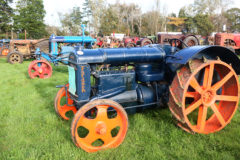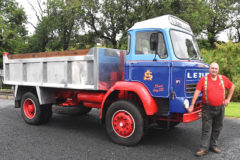A quartet of giant, Muir-Hill tractors
Posted by Chris Graham on 19th December 2021
Chris Graham meets Jonathan Playfoot and his quartet of giant, Muir-Hill tractors that were acquired almost by accident!
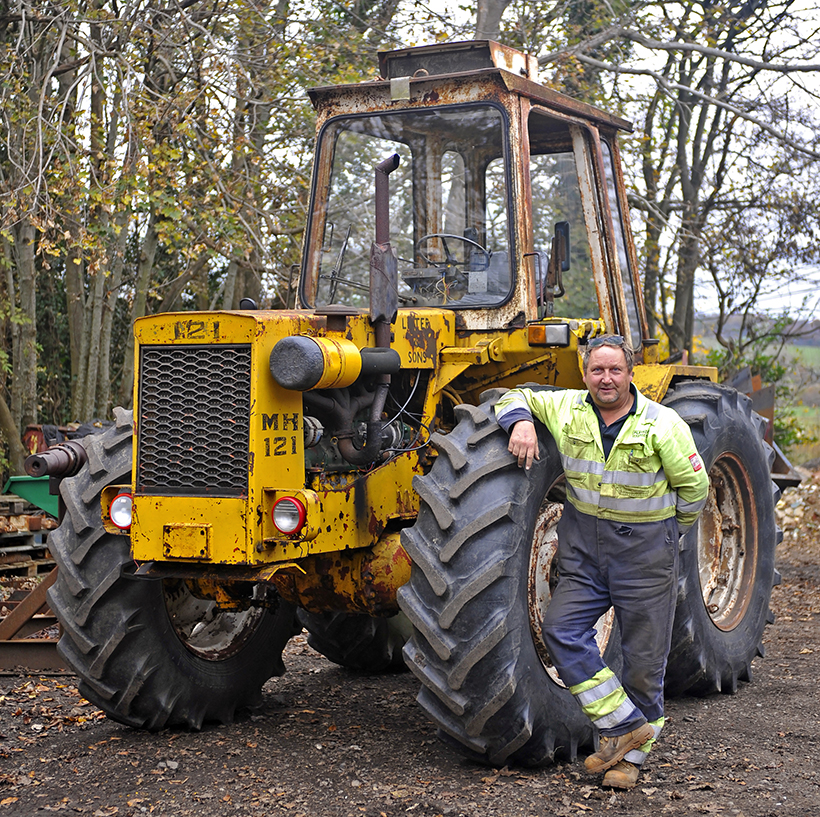
A quartet of giant, Muir-Hill tractors: Jonathan Playfoot and his 1973 Muir-Hill 121 proudly wearing its working clothes.
Jonathan Playfoot is living the tractor enthusiast’s dream! From boyhood, he had an unquenchable interest in virtually anything that relied on an engine and, such was his love of tractors that he decided that driving one was what he wanted to do for a living. However, his father had other ideas and – quite rightly, as it turned out – encouraged the young Jonathan down an alternative career path.
He trained as a plasterer and ran a very successful business doing that for 16 years, after which back problems forced a change. It was at this point that he decided to join the family firm, East Sussex-based Playfoot Engineering. The company, which is based in rural Bodiam, specialises in the design and fabrication of just about anything that’s made of metal plus onsite maintenance and Welding. So, whether you want structural girders for a new warehouse, the tubular frame for a dining room table or a new alternator bracket for a classic tractor, Jonathan’s your man!
A clear passion
Take a stroll around Playfoot Engineering’s rambling, multi-level yard and Jonathan’s love of all things engine-related soon becomes apparent. Apart from the three Muir-Hills that are impossible to miss, my guided tour also revealed a varied assortment of other tractors, a complex piece of mining equipment that was in for a service, a bright orange Austin 7, a stack of glass fibre Elva sportscar bodyshells (the Elva factory was in nearby Bexhill) plus more fascinating parts and components at every turn!
So, I was interested to find out how it all started for Jonathan, and what was at the root of his fascination with tractors? “I’ve had a keen interest in tractors of all sorts for as long as I can remember,” he told me, “but, although I worked on farms at various times when I was a child, my family had no direct link with farming.
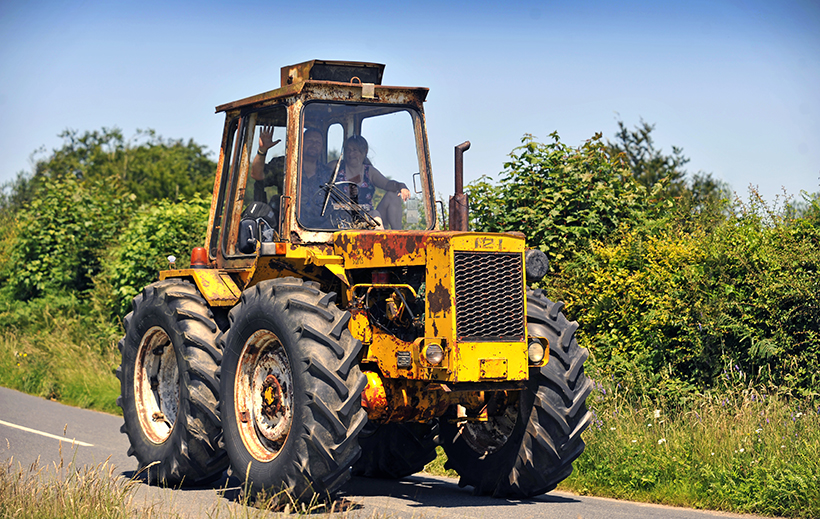
Jonathan gets out and about in the 121 as much as he can. This was him, with Yvonne by his side, on the Mad Jack Fuller road run near Brightling, East Sussex, back in the summer.
Early experience
“I got my first tractor back in the late 1980s, and it was a Zetor Crystal 8011. I had a lot of experience with these Czech-built machines – especially the Crystal – when I was younger, so have retained a soft spot for them ever since. The Muir-Hills didn’t arrive until 2014 and, to be honest, my association with these machines all started from a chance encounter.
“I didn’t have a specific interest in the make, but was obviously aware of the brand. I knew they were big, powerful machines, which made them appealing. We do some machining work for a local farmer called John Lister, over in Staplecross, and I’ve known him for many years. It was while visiting him one day, that John happened to show me a pair of his Muir-Hill tractors; a 1971 101 and a 1973 121.
“They were tucked away in a shed, and I remember being struck by the sheer scale of them both; they certainly made a big impression on me. What’s more, I also spotted another couple of 121s parked out in the yard – 1975 and 1976 Series 2 models – one of which was still being regularly used for grass topping on the farm.
“As I left, I mentioned to John that if ever he thought he might want to sell either of them, I’d be very interested in buying one. That’s a remark that I often trot out to people if I spot something interesting during a site visit and, to be honest, I didn’t think much more about it after that.”
Incoming call
“Then, two weeks later, I got a call from John who wanted to know if I was serious about buying a Muir-Hill and when, on the spur of the moment I told him that I was, he invited me back to pick the one I wanted. Both models were very much in their working clothes, but were complete and standard, although the 101 had been fitted with a reduction ‘box at some point during its working life – I think it had been used for specialist drainage work, or pulling out tree stumps on the farm.

This 1975 Muir-Hill 121 has been fitted with a 180hp DAF truck engine at some point in the past. It’s not currently roadworthy.
“After some thought, I opted for the 121, only because it was slightly newer and more my era. Then John explained that both machines had been driven into the shed 25 years earlier, parked and then not touched since. However, he promised that he’d be able to get the 121 running for me before he delivered it, which was good enough for me. Normally, with a ‘barn find’, it falls on the buyer to get the engine running (if possible) and then arrange to transport it off the site. In this case, though, John was happy to tackle this for me, and then deliver the tractor to me as part of the deal, which was brilliant.
“Then, a week or so later, I heard from John again, with the news that the 121 was running and movable, but that he had another question for me. He’d had a word with his son and now wanted to know if I’d like to buy the 101 as well? Well, my immediate reaction was that I shouldn’t even have committed to the 121, let alone be considering another one on top! So, I told John that it was time for a consultation with Yvonne.
“Fortunately, Yvonne fully appreciates my fascination with mechanical things. In fact, she’s just as enthusiastic about driving and using old tractors as I am, and it didn’t take us long to decide that owning ‘his and her’ Muir-Hills would be fun. So, we said ‘yes to the 101, as well!”
Five weeks later there was another call from John. “This time he wanted to know if I fancied taking the other two 121s off his hands,” Jonathan explained. “My instinctive reaction was to say no, but I also knew how irritating it is to miss an opportunity then spend the years afterwards ruing that decision. So, I decided to take the plunge, and that’s how I ended up with four of these amazing machines!
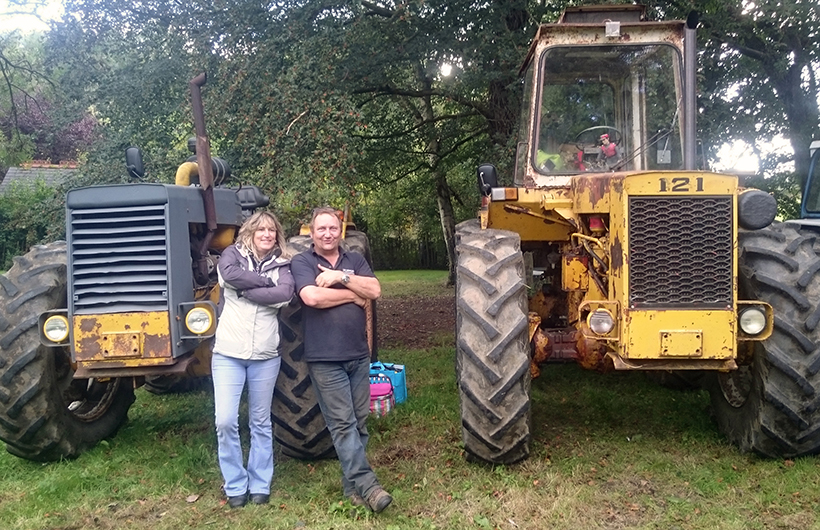
Yvonne and Jonathan with their ‘his and her’s’ Muir-Hills. The 101 (on the left) is the one Yvonne loves to drive…
Delivery day!
John was as good as his word and delivered the 1973 121 and the 101 to Jonathan’s yard on the back of a low-loader. Both were able to start and reverse off the trailer under their own steam, although the brakes certainly weren’t up to much, which made things interesting. He then went and picked up the second, two-tractor load; the 1975 121 now called Daffny because of its 180hp Daf lorry engine and very wide, tera tyres, the 1976 121. We even had to cut a tree down along our drive so that Daffny would fit through.
“The two latest models arrived with a whole host of spare parts, including several wheels and many front weights, once everything was unloaded, even my extensive yard was starting to look a bit crowded! But it was great to have them all with me, and to know that all four had been used on the same, East Sussex farm for many years.
All that took place nearly seven years ago, so I was interested to find out more about what had happened to the Muir-Hill quartet since. It turns out there have been a few developments. “All four run,” Jonathan told me, “but only two of them are currently road-legal – the 1973 121 that I use regularly at shows and on local road runs, and the cabless 1971 101 that’s Yvonne’s tractor, which she calls Russell.
“However, we had a problem with the engine fitted in the 1976 121, which developed a problem with its fuel lift pump. Yvonne was driving it and, unbeknown to her, the pump failed and dumped a load of diesel into the sump. This got circulated around the engine and caused some quite serious internal damage before she realised what was happening. That tractor is awaiting an engine rebuild, although it still runs and can be moved about the yard, if needs be.
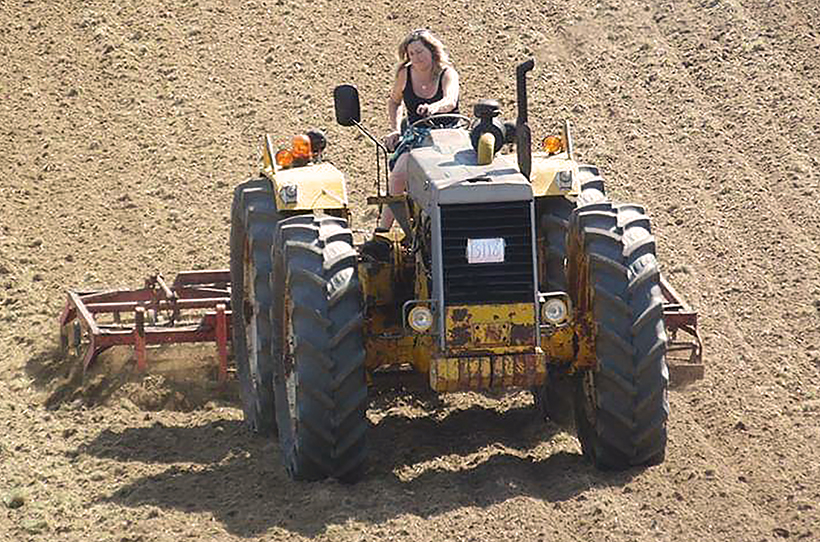
… and work, whenever she gets the opportunity.
“That happened a week before our local Rural Pastimes show in 2014, at which the tractor was scheduled to make an appearance. So, we spent our evenings for the following five days working late into the night to bring the roadworthy 1973 121 up to scratch, so that it could take the 1976 121’s place at the show. This involved fitting another radiator plus brake slave and master cylinders, and swapping some wheels around.
“The 1973 121 had to be fitted with a replacement, low-hours, Ford 2715 engine, which I got out of a generator. Yvonne’s 101 is currently in bits because one of the shafts in the reduction box has worn its splines. We were alerted to this by the noise it was making and, once stripped, the wear-related damage was clear to see – the cast, female part of the spline has simply been stripped of its teeth.
“The main gearbox will be rebuilt and, because the tractor is already in four pieces, I’m going to take the opportunity of cleaning, prepping and then painting it. We’re also getting the 1975 180hp 121 ready for our local, Boxing Day tractor run, with the worked needed centring on the radiator, brakes, lights and tyres.
General thoughts
Although Jonathan stumbled upon his four Muir-Hills by chance, he was well aware of the Manchester then Gloucester-based manufacturer, and has a particular childhood memory of the big, yellow machines. “I can remember a local driver – Tom Thomas – who helped out at Southover Contractors when I was growing up. That company ran a couple of Muir-Hills and a County and, although I never got the chance to drive any of them, I do recall taking photographs of the 121s as they worked.” Clearly, then, the Muir-Hill seeds were sown in Jonathan’s brain at an early age!
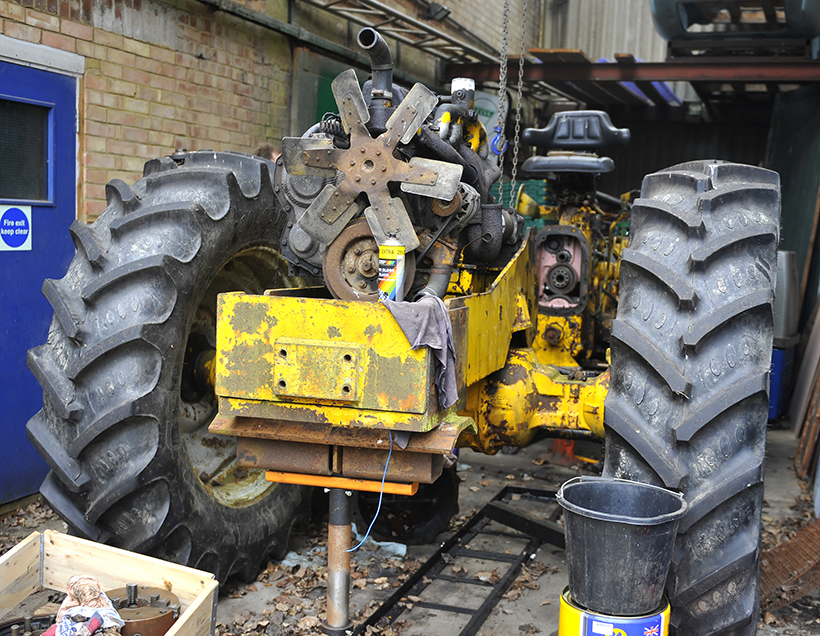
Unfortunately, the 101 is in bits at the moment while a problem with a stripped reduction box shaft spline is dealt with. A gearbox rebuild is also on the cards for this one, followed by a repaint, Jonathan hopes.
Now, with the benefit of plenty of Muir-Hill ownership experience, Jonathan is well placed to comment on the marque, generally. “The way the market is at the moment, there’s no doubt that County tractors are at the top of the desirability tree,” he told me. “They’re just incredibly sought-after at the moment and prices have gone through the roof.
“However, I consider that, in pure engineering terms, the Muir-Hill is a superior machine. It’s my impression that a lot more thought was put into the design of models like the 101 and 121, than was the case with County equivalents. For example, the Muir-Hill’s drop box, which allows for a center drive to the front axle, delivers a genuine, practical advantage. A Muir-Hill’s turning circle is much tighter than that offered by the County alternative, and I think that that additional maneuverability is a really useful out in the real world.”
Marketing triumph
“Nevertheless, for whatever reason, County grabbed the high ground in marketing terms, built a strong reputation and has been top of the tree ever since. It’s now regarded as the Rolls-Royce of the four-wheel-drive conversions, and that position seems to be set in stone. I’m sure that the close link with Ford did much to help establish a good image early on, even though Muir-Hill used Ford skid units, as well.
“I’m not sure how many Muir-Hills were made altogether, but know that production began in 1966, with the 101 model. The 121 followed a few years later, and was upgraded to the Series 3 in about 1976. There was also the 110,111 model, which was powered by a Perkins diesel engine. The company introduced the 161in 1969 and 171in 1975, which were powered by Perkins V8s but, by this stage, I don’t think that the tractors were built around Ford skid units. Although the V8 models certainly delivered a lot of horsepower, they were a bit of a Bitsa in terms of the components used.
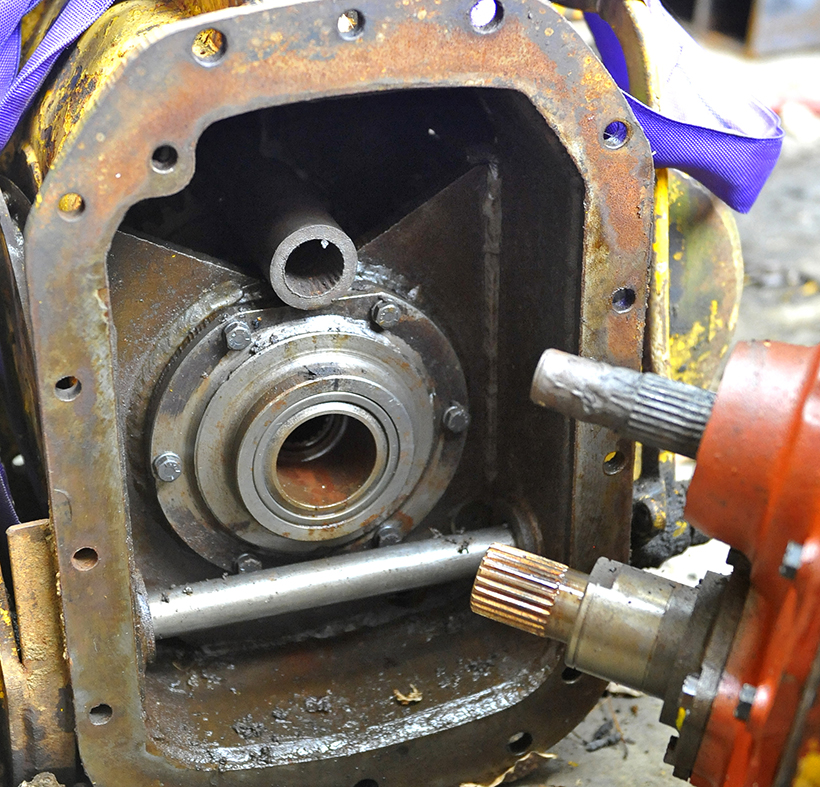
You can just see here, where the upper shaft locates, how the splines in the 101’s reduction box have been worn away.
“A decent number of Muir-Hills were built, but nothing approaching the number that left the County factory in Fleet. However, the name lives on as the company was bought by Lloyd Loaders – I think in the 1990s – and, although no tractors are produced anymore, the company does still sell Muir-Hill parts from its base in Halifax. What’s more, we now make some parts for them to sell, as we have the skills and machinery here to batch-produce components in limited numbers.”
Original appearance
I find it refreshing that Jonathan isn’t obsessed with bringing his tractors back to Concours-like condition. In fact, he’s more than happy to drive and use them in their working clothes. “I have no problem with taking them to shows and events in their unrestored condition,” he explained, “as I think that their current appearance reflects what they are; tractors that are about 50 years old and that have worked hard during that time.
“While I’m sure that I’ll eventually get around to smartening them up, I certainly won’t be undertaking nut and bolt-type, two-pack paint restorations. Tractors are utility vehicles that were designed to do a job of work in a tough environment, and I see little point in restoring them to a condition that’s better than they ever were when new.
“When the lockdown hit last year, I thought that it would provide an ideal opportunity to really crack on with some renovation work on the Muir-Hills, so rushed out and bought all the primer, undercoat and Muir-Hill yellow topcoat that I would need to paint them. As it turned out, though, I’d furloughed several members of staff and, because the orders then started flooding in, I found myself busier than ever, and had no time to do anything with the tractors!
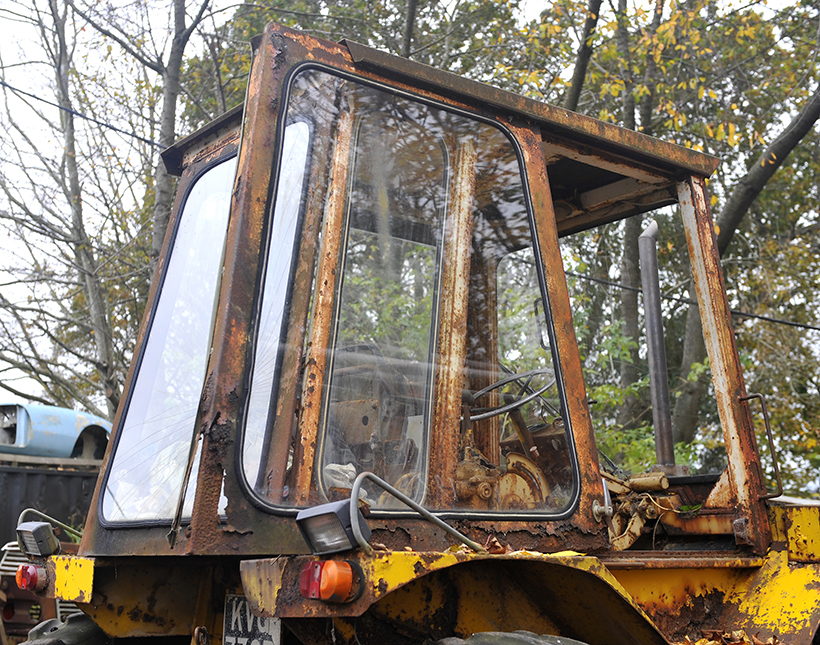
All the cabs on Jonathan’s Muir-Hills are in need of serious work. Fortunately, his company possesses a CNC plasma cutting machine, which should make short work of cutting out the panel sections needed to replace the corroded areas.
“However, I’m determined to make progress with them, and have all the work needed mapped out in my mind. We have a CNC plasma cutting machine in the workshop, so creating the panels I’ll need to restore the cabs isn’t a problem. It’s simply a case of finding the spare time needed to get things moving. The trouble is, I’ve got plenty of other tractor-related projects on the go so, as always, it’s a matter of juggling priorities. In the meantime, I’m delighted that I bought all four of these brilliant machines when I had the chance and am convinced that I did the right thing.”
For a money-saving subscription to Ford & Fordson Tractors magazine, simply click here



